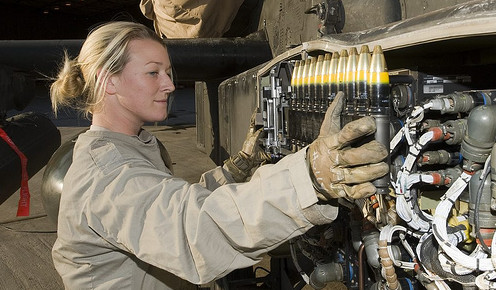by Albert Anderson
For over 200 years the men of the United States Armed Forces have served in combat roles the world over. In the popular imagination, this conjures images such as G.I. Joe defeating the Cobra terrorists or Rambo shooting his way through the jungles of Vietnam. However, following Secretary of Defense Leon Panetta’s lifting of the 1994 ban on women in combat in January 2013, some might say the next generation of military icons will more closely resemble G.I. Jane than Sylvester Stallone.
Momentum for this change has arguably been building since World War I, and the response has been generally positive: from the Joint Chiefs of Staff who suggested the change, from President Barack Obama and even from Senator John McCain. But whether you agree or disagree with the policy, you can’t help but wonder: Why has this happened now? With hot-button issues such as gay marriage and gun control dominating headlines, lifting the ban seems to have come out of nowhere, and many are wondering what implications this change will have on the military moving forward.
Historically, women have played an active, though not frontline, role in the U.S. military. Their primary role as nurses evolved significantly during World War I and World War II to include responsibilities in communications and administration. Their duties expanded even further in the 1970s and ’80s as more channels for advancement opened, allowing women to serve as military police and transportation specialists. By the ’90s, women were serving in combat in both the Navy and Air Force.
In 1994, however, this trend saw a setback with the ban on women in combat, though it was not all-encompassing as commonly portrayed. Rather, it specifically targeted combat-intensive ground roles such as those in infantry, artillery, and armored units. Thus, the lifting of the ban is not going to result in any dramatic flood of female troops—women have already thoroughly permeated the military in other roles.
As natural as the announcement seems after examining the historical progression of the issue, its timing was in reality shocking. There was almost no public discourse on the topic at the time, and other issues dominated the news. Even White House staffers were reportedly taken by surprise. Some theorize that perhaps Secretary Panetta, who was soon to retire, lifted the ban in order to create an instant legacy for himself. He denied such motivations, stating in a press conference that he was inspired to lift the ban after his encounters with female military personnel in Iraq, Afghanistan and here in the United States. After visiting both war zones, he was “impressed with the fact that everyone, everyone men and women alike, everyone is committed to doing the job. They’re fighting and they’re dying together, and the time has come for our policies to recognize that reality.”
The lifting of the ban will open over 200,000 positions that were previously unavailable to women. The military’s five branches must each devise a plan within the next couple of months to implement the necessary changes and to provide rationale for keeping any elite units, such as the Navy SEALs, male-only. Panetta also made clear that the rigorous physical standards of the military will not be compromised. Women will now have the same opportunity as men to qualify but will not receive exceptional treatment.
Critics of the change have voiced several concerns, among them that women’s physical limitations, relative to men, will set them at a disadvantage and that the further integration of women into military units will disrupt the cohesion present in an all-male fighting force. Another concern is that the lifting of the ban will harm recruitment efforts, as women who would have served under the ban may decide not to enlist out of a desire to avoid combat deployments.
On the contrary, director of the Service Women’s Action Network Anu Bhagwati, feels that the ban’s repeal will serve the opposite end: “This will have a positive effect on recruitment and retention efforts. If women feel they can advance and achieve in our military, we are more likely to attract the best and brightest.”
Bhagwati brings to light an interesting effect of Panetta’s policy change: the creation of thousands of opportunities for promotion that did not exist for women just weeks ago. Depending on how many posts women ultimately fill, the number of female officers could increase noticeably in the coming years.
Another implication of the ban, largely overlooked by the media at large, is the inevitable change in the military’s image, both at home and abroad. The United States now joins countries such as China, Israel and Australia in having female combat troops. Coupled with the recent repeal of the “Don’t Ask, Don’t Tell” policy, the U.S. military now stands as one of the more inclusive forces in the world—meaning the stereotype of the soldier in American culture as a straight male will have to undergo a revision.
The rules of the military have always changed to fit the views and expectations of society, even if these changes come a bit more slowly than some would hope. For the time being we can only conjecture as to how a greater female presence will alter the military, its culture and its image as we know them.
Albert Anderson ’15 is an International Relations concentrator.
